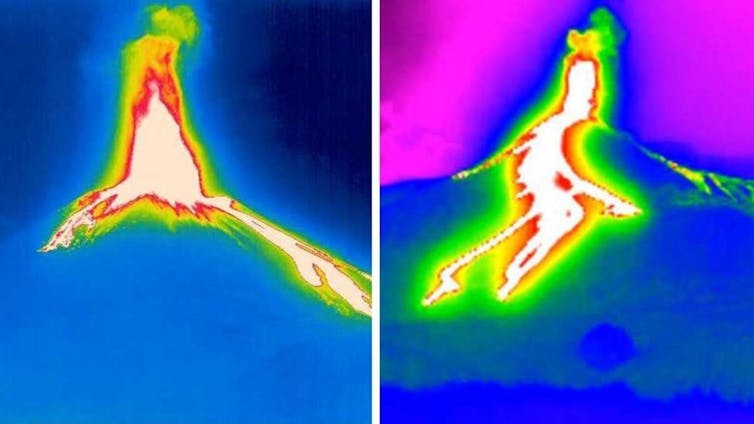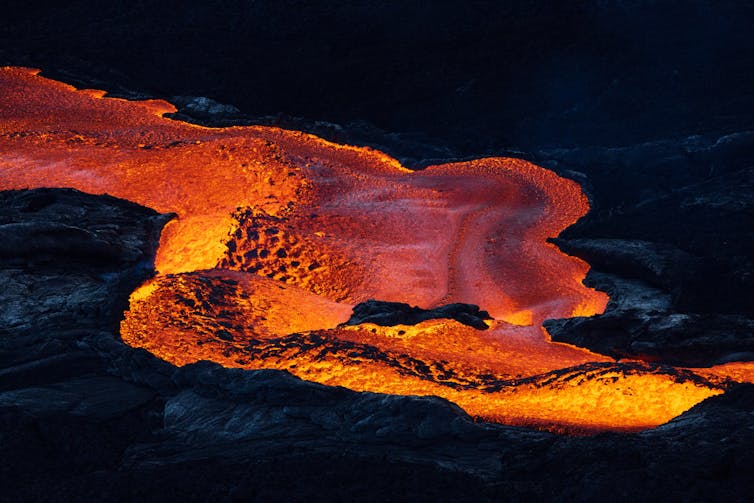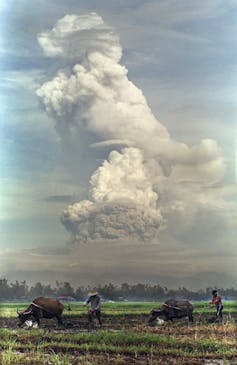Monday morning, local time, a huge cloud of fragments of ash, hot gas and rock started spitting Etna from Mount Italy.
A huge plume has been seen extending several kilometers in the mountain sky on the island of Sicily, which is the largest active volcano in Europe.
While the explosion has created an impressive show, the eruption did not lead to any injury or damage reported and barely disrupted thefts on or out of the island. The eruptions of Mount Etna are commonly describe As “Strombolian eruptions” – but as we will see, this may not apply to this event.
What happened to Etna?
The eruption started with an increase in pressure in hot gases inside the volcano. This led to the partial collapse of part of one of the craters at the top of the Etna.
The collapse allowed what is called a pyroclastic flow: a quick cloud of ash, hot gas and fragments of bright rock from the inside of the volcano.

National Institute of Geophysics and Volcanology,, CC by
Then the lava started to flow in three different directions on the edge of the mountain. These flows are cooling now. Monday evening, the Italian National Institute of Geophysics and Volcanology announcement Volcanic activity had ended.
Etna is one of the most active volcanoes in the world, so this eruption is reasonably normal.
What is a Strombolian eruption?
Volcanologists classify eruptions by their explosive. More explosive eruptions tend to be more dangerous because they move faster and cover a larger area.
At the sweetest end are the Hawaiian eruptions. You have probably seen photos of these: lava flowing on the slope of the volcano. The lava damages everything it encounters, but it is a relatively local effect.
While the eruptions become more explosive, they send ashes and fragments of rock flying further.
At the more explosive end of the ladder are Plinian eruptions. These include the famous eruption of Vesuvius in 79 AD, described by the youngest Roman writer Pliny, who buried the Roman cities of Pompeii and Herculanum under meters of ashes.

Bruce Omori / Paradise Helicopters / EPA
In a plinian eruption, hot gas, ashes and rock can explode high enough to reach the stratosphere – and when the eruption column collapses, debris fall on earth and can cause terrifying destruction on a huge area.
What about Strombolian eruptions? These relatively light eruptions are named after Stromboli, another Italian volcano which learns a minor eruption every 10 to 20 minutes.
In a stringed eruption, pieces of rock and ash can travel dozens or hundreds of meters in the air, but rarely further. The pyroclastic flow of yesterday’s eruption in Etna was rather more explosive than that – it was therefore not strictly Strombolian.
Can we predict the eruptions of the volcano?
Volcanic eruptions are a bit like time. They are very difficult to predict in detail, but we are much better than we predicted.
To understand what a volcano will do in the future, we must first know what is going on inside at the moment. We cannot look directly inside, but we have indirect measurements.

Bullitt Marquez / AP
For example, before an eruption, the magma moves from the deepest inside the earth to the surface. On the way, it pushes the rocks and can generate earthquakes. If we record the vibrations of these earthquakes, we can follow the trip of the magma from the depths.
The growing magma can also make the ground near a bulge of the volcano upwards, a few millimeters or centimeters. We can monitor this bulge, for example with satellites, to collect indices on an upcoming eruption.
Some volcanoes release gas even when they do not break out strictly. We can measure chemicals in this gas – and if they change, it can tell us that the new magma is on the way to the surface.
When we have this information on what is happening inside the volcano, we must also understand his “personality” to find out what information means future eruptions.
Are volcanic eruptions more common than in the past?
As a volcanologist, I often hear people that it seems that there are more volcanic eruptions now than in the past. This is not the case.
What is happening, I tell them is that we now have better surveillance systems and a very active global media system. So we know more eruptions – and even see photos of them.
Surveillance is extremely important. We are fortunate that many volcanoes in places like Italy, the United States, Indonesia and New Zealand have excellent surveillance in place.
This surveillance allows local authorities to issue warnings when an eruption is imminent. For a visitor or a tourist to see the wonderful natural wonder of a volcano, listening to these warnings is important.

